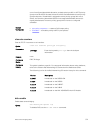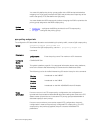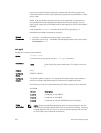
priority-group
To use with an ETS output policy, create an ETS priority group.
Syntax
priority-group group-name
To remove the priority group, use the no priority-group command.
Parameters
group-name Enter the name of the ETS priority group. The maximum is 32
characters.
Defaults none
Command
Modes
CONFIGURATION
Command
History
This guide is platform-specific. For command information about other platforms,
refer to the relevant Dell Networking OS Command Line Reference Guide.
The following is a list of the Dell Networking OS version history for this command.
Version
8.3.19.0
Introduced on the S4820T.
Version
8.3.12.0
Introduced on the S4810.
Version
8.3.16.0
Introduced on the MXL 10/40GbE Switch IO Module.
Usage
Information
NOTE: Please note that Dell Networking does not recommended to use this
command as it has been deprecated in the current 9.4.(0.0) release. A warning
message appears when you try to run this command indicating that you have
to use the dcb-map commands in the future.
A priority group consists of 802.1p priority values that are grouped for similar
bandwidth allocation and scheduling, and that share latency and loss requirements.
All 802.1p priorities mapped to the same queue must be in the same priority group.
You must configure 802.1p priorities in priority groups associated with an ETS
output policy. You can assign each dot1p priority to only one priority group.
The maximum number of priority groups supported in ETS output policies on an
interface is equal to the number of data queues (4) on the port. The 802.1p
priorities in a priority group can map to multiple queues.
If you configure more than one priority queue as strict priority or more than one
priority group as strict priority, the higher numbered priority queue is given
preference when scheduling data traffic.
574
Data Center Bridging (DCB)





















